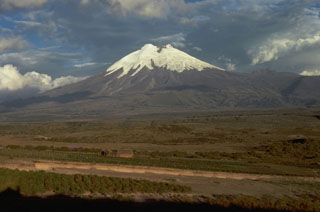Report on Cotopaxi (Ecuador) — 12 August-18 August 2015
Smithsonian Institution / US Geological Survey
Weekly Volcanic Activity Report, 12 August-18 August 2015
Managing Editor: Sally Sennert.
Please cite this report as:
Global Volcanism Program, 2015. Report on Cotopaxi (Ecuador) (Sennert, S, ed.). Weekly Volcanic Activity Report, 12 August-18 August 2015. Smithsonian Institution and US Geological Survey.
Cotopaxi
Ecuador
0.677°S, 78.436°W; summit elev. 5911 m
All times are local (unless otherwise noted)
On 14 August IG reported an earthquake swarm at Cotopaxi that began at 1721 and ended at 1806; the largest event, detected at 1723, was a M 2.7. A series of phreatic explosions on 15 August started with two small ones detected at 0402 and 0407. According to the Washington VAAC, ash plumes rose to altitudes of 12.2-13.7 km (40,000-45,000 ft) a.s.l.; lower parts of the plume drifted E and higher parts drifted SE. Ashfall occurred in areas to the N. IG noted that an explosion at 1027 generated an ash plumes that rose to an altitude of 17.9 km (58,700 ft) a.s.l. and drifted NW and E. A pyroclastic flow descended the W flank. The VAAC initially reported that ash from that event drifted 17 km W, 20 km NNW, and 8 km SE, and that plumes may have risen as high as 15.2 km (50,000 ft) a.s.l. and possibly higher. According to news articles, ashfall was reported in El Chasqui (48 km N), Machachi (22 km NW), Tambillo (32 km NNW), and in areas in S Quito (~45 km N) including Cutuglagua, Guamaní, Chillogallo, Santa Barbara, and Solanda. Parts of the Cotopaxi National Park was closed to visitors.
During 15-16 August sulfur dioxide emissions were high, and remobilized ash from the W flank rose up to 3.3 km; no ashfall was reported and only minor amounts of a sulfur odor were noted by residents. Ash plumes rose 300 m on 17 August and drifted W; at 1824 an ash emission rose 700 m and drifted W. During times of clear views observers noted that winds pushed ash plumes down the W flank.
Geological Summary. The symmetrical, glacier-covered, Cotopaxi stratovolcano is Ecuador's most well-known volcano and one of its most active. The steep-sided cone is capped by nested summit craters, the largest of which is about 550 x 800 m in diameter. Deep valleys scoured by lahars radiate from the summit of the andesitic volcano, and large andesitic lava flows extend to its base. The modern edifice has been constructed since a major collapse sometime prior to about 5,000 years ago. Pyroclastic flows (often confused in historical accounts with lava flows) have accompanied many explosive eruptions, and lahars have frequently devastated adjacent valleys. Strong eruptions took place in 1744, 1768, and 1877. Pyroclastic flows descended all sides of the volcano in 1877, and lahars traveled more than 100 km into the Pacific Ocean and western Amazon basin. Smaller eruptions have been frequent since that time.
Sources: Instituto Geofísico-Escuela Politécnica Nacional (IG-EPN), Washington Volcanic Ash Advisory Center (VAAC), El Comercio

